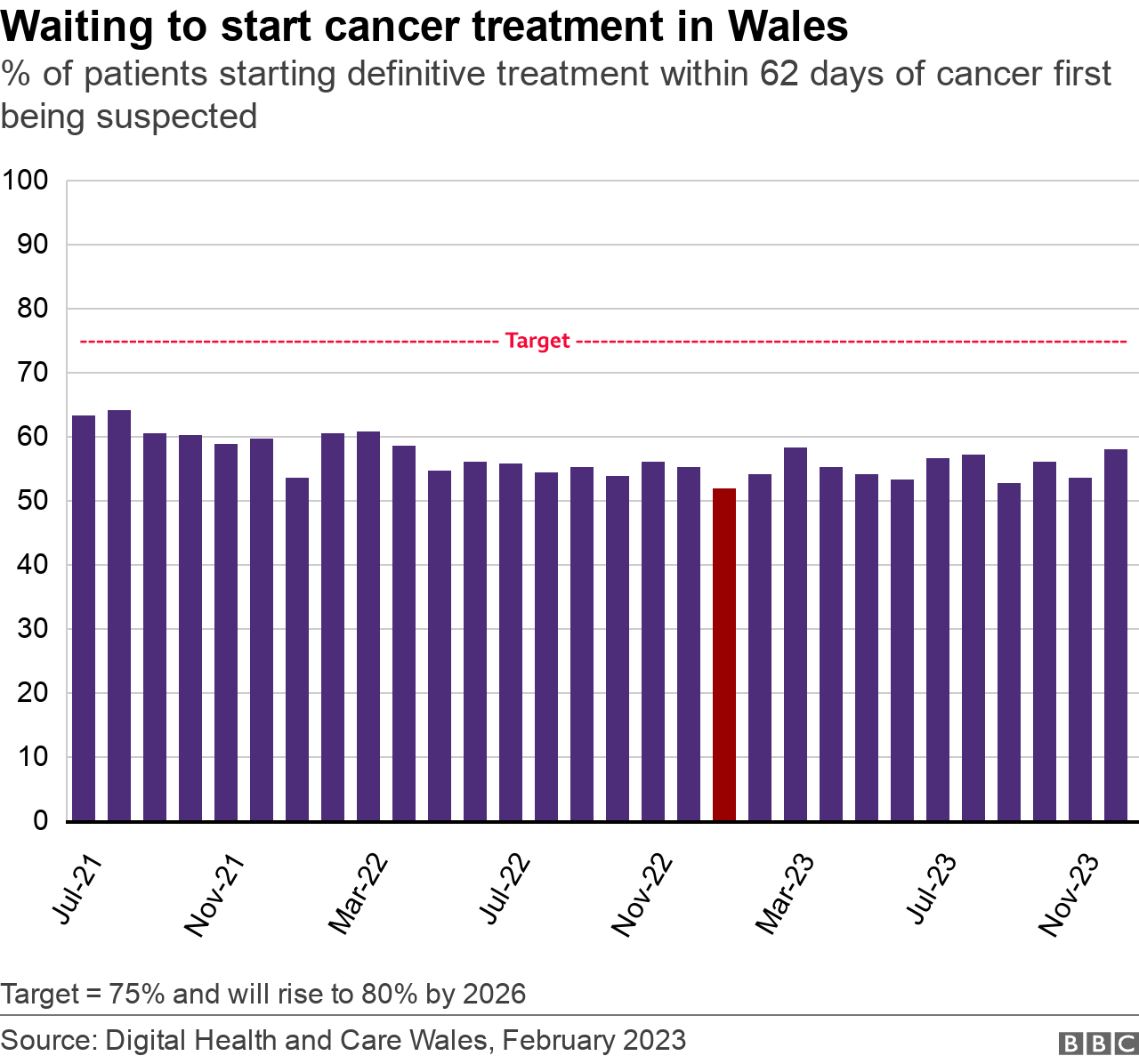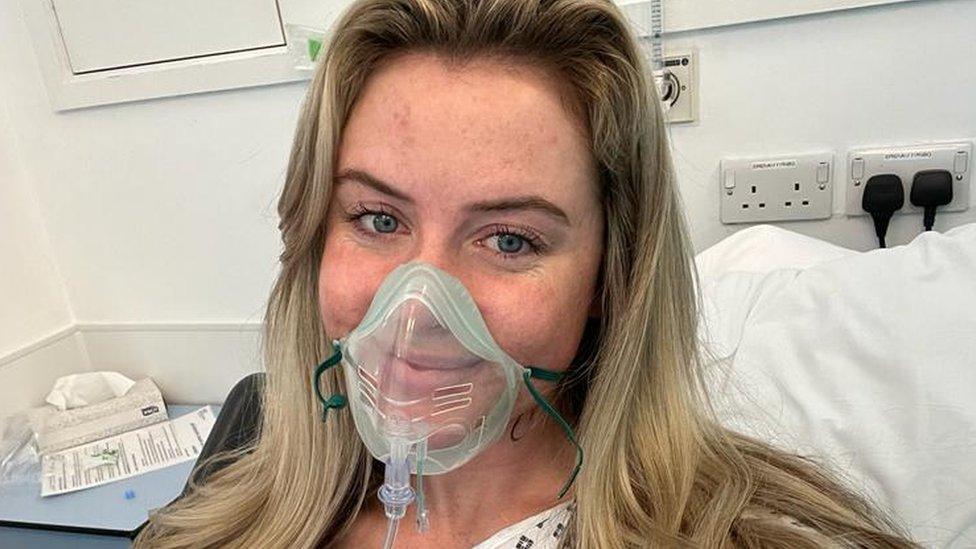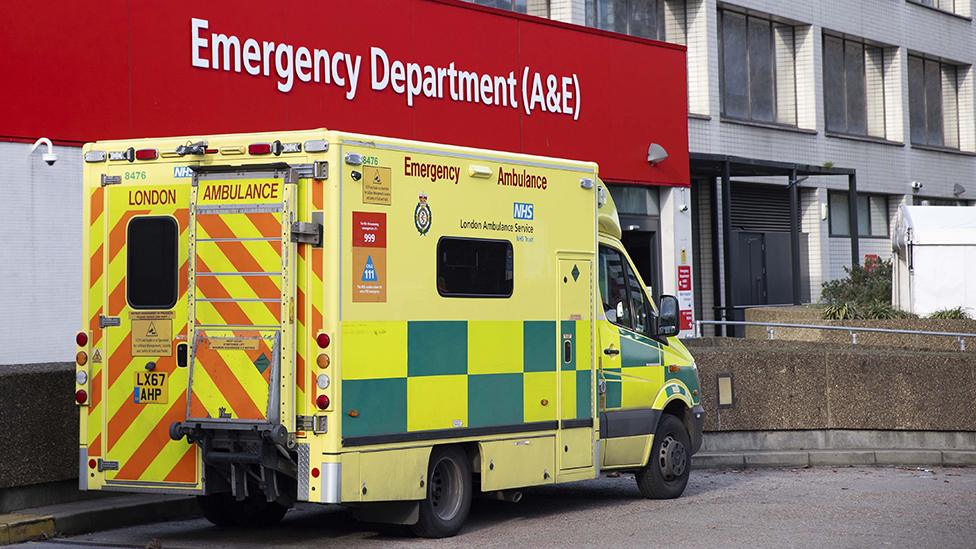NHS Wales: Hospital waiting times improve for second month
- Published

NHS Wales is performing relatively better than England in its A&E performance
Numbers on hospital waiting lists have fallen for a second successive month in Wales, figures show.
There were 756,333 "patient pathways" on the waiting list in December and Health Minister Eluned Morgan said she was "delighted" at another fall.
However, the Royal College of Surgeons said the waiting list was "essentially in limbo".
There were improvements under the cancer targets and small improvements in A&E and ambulance waiting times.
But there was an increase in those waiting more than a year for hospital treatment, similarly those waiting for outpatient appointments.

Cancer waiting times showed the most improvement in the best position for nine months.
A total of 58% of people who were suspected of having cancer saw their treatment start within 62 days, although this is still below the target figure of 75%.
The Welsh government also pointed to the number of people told they do not have cancer being at the highest figure on record for any December.
Charity Cancer Research UK said it was "unacceptable that thousands of cancer patients across Wales face huge anxiety as they wait too long to be diagnosed and treated".
"The Welsh government must address the chronic staff shortages and lack of specialist facilities contributing to these long waits."
Ambulance response times to life-threatening calls were roughly the same as the previous month (down 0.1%) - with 48.8% arriving within eight minutes.
It was the third busiest month for these "red" calls on record.
There were also 26,755 "lost" hours - the combined total of time that ambulances had to wait before handing over patients at A&E units.
This was the fourth highest figure on record.

In accident and emergency, 68.4% of patients were seen within four hours - an improvement on the previous month.
Glan Clwyd was the worst-performing against the target, with only 45.1% discharged, transferred or admitted within four hours.
There were also 9,939 patients who waited more than 12 hours, a rise on the previous month - and 10% higher than the previous January.
When we compare with A&E in England - and only look at major emergency units - then Wales is performing better for the fifth successive month. In Wales, 58% of patients were seen within four hours, compared to just over 55% in England.
The average waiting time was two hours and 44 minutes, eight minutes quicker than the previous month.
There were 756,333 "patient pathways" on the waiting list for treatment after referral in December.
This was 2,482 fewer than the previous month.
But when we look at those waiting the longest, there was an increase of 3,784 in those waiting more than a year to 140,322.
When we look at consultant-only specialisms, to compare with England, then 20.8% of patient pathways on the list were waiting more than a year in Wales, compared to just 4.4% of the list in NHS England.

This is more than 167,000 patient pathways in Wales.
There were also 24,244 in Wales waiting more than two years - a small monthly drop - and only 282 waiting that long in the whole of England.
Because some patients are on more than one waiting list, it is estimated that 584,000 people are on waiting lists.
We can also see that there were 1,548 patients - mostly elderly - who were still in a hospital bed, even though they were well enough to be discharged.
This included more than 650 patients who were delayed because of assessment issues around their care.
There were 56,936 patients waiting more than a year for a first outpatient appointment.
This figure has risen for a third successive month, when the post-Covid recovery plan target is that no-one should wait this long.

There were also more than 50,500 waiting longer than the eight-week target for diagnostic services.
This is an increase on the previous month - and more than 10 times the number we saw before the pandemic.
What has been the response?
Prof Jon Barry, Welsh director of the Royal College of Surgeons, said: "Waiting lists in Wales are essentially in limbo, showing no significant improvement for months.
"With the equivalent of one in four people in Wales on the waiting list for treatment, more needs to be done. Too many patients are being left to wait in pain, and uncertainty, for the day they might have their operation."

Conservatives, highlighting the two-year waits, said the latest statistics were "further evidence of Labour's gross mismanagement of our Welsh NHS".
Health spokesman Russell George added: "When Labour should be tackling waiting lists and fixing our broken NHS, they are spending precious resources on more politicians in Cardiff Bay."
Plaid Cymru's health spokesman, Mabon ap Gwynfor said the Welsh government were in denial and had run out of ideas.
"Waiting figures remain stubbornly high," he said. "The amount of pathways waiting for over a year for treatment are continuing to rise. All health boards are in some form of targeted escalation. Cancer services are calling out for support."
Health Minister Eluned Morgan said: "It is disappointing to see one-year waits for a first outpatient appointment increase, and the number of waits of longer than eight weeks for diagnostic services rise. The overall number of waits for diagnostic services did fall however."
But she praised the work of "heroic staff" working under intense pressure during the winter period.

JUNE: VOICE OF A SILENT TWIN: The tragic story of June, her sister and their life in Broadmoor
DEATH OF A CODEBREAKER: The man found naked & dead inside a bag

Related topics
- Published20 July 2023

- Published8 March 2023

- Published15 February 2024

